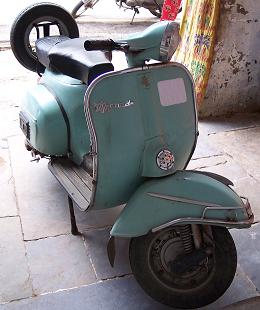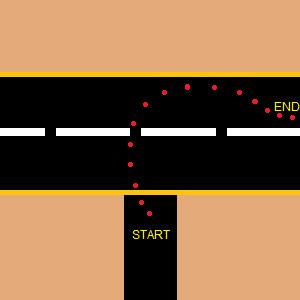It’s hardly six months since Bajaj Auto Ltd announced its withdrawal from the scooter market in India. This essentially meant that one of the common household names and valiant family carrier – the Bajaj Chetak – faced a total phase-out.
Hamara Bajaj Chetak
 The Bajaj scooter – ‘Hamara Bajaj’ as in Rahul Bajaj’s most successful campaign – has been there in the Indian market for almost 40 years with three models – the most successful Chetak, Super and 150. For the middle class Indian family consisting of a husband, wife and two to four kids, this vehicle was like their family member that carried the entire family and their accessories through the rough roads and under all kinds of weather conditions. Its toughness and low maintenance cost made it super successful in India though the surge of Japanese two-wheelers in the mid 80’s slowly forced it out of the game. It is really hard to forget some of those scenes that all of us have witnessed, admired and laughed at times.
The Bajaj scooter – ‘Hamara Bajaj’ as in Rahul Bajaj’s most successful campaign – has been there in the Indian market for almost 40 years with three models – the most successful Chetak, Super and 150. For the middle class Indian family consisting of a husband, wife and two to four kids, this vehicle was like their family member that carried the entire family and their accessories through the rough roads and under all kinds of weather conditions. Its toughness and low maintenance cost made it super successful in India though the surge of Japanese two-wheelers in the mid 80’s slowly forced it out of the game. It is really hard to forget some of those scenes that all of us have witnessed, admired and laughed at times.
The retro-commercial featuring Hamara Bajaj
Peculiar things about a Bajaj scooter
Though there are variations across different models, the typical Bajaj scooter weighs around 110Kg. However, it could pull double its weight without causing much trouble.
Since the engine is planted on the right side, it always had an imbalanced while riding whereby the scooter tends to move towards the right if you are not careful. This was one of the issues for beginners who tried their hands on a Bajaj.
To fix this problem, they in fact placed the tyres in an offset position. In other words the front and rear tyres are not in a straight line but has a slight offset. I was surprised to learn this from one of the old timers that I have known.
The split seats were never designed with the ergonomics in mind but the need to accommodate the ever-responsible family head and the fat-bottomed typical Indian house wife and their kids (in all available gaps)
How to start a Bajaj Chetak – the sequence of operations
This is the funniest part. From what I have seen and witnessed it involves the following operations in exact same sequence.
1. Insert the ignition key in the handle lock keyhole. Turn the key vigorously three to four times while simultaneously turning the handle to make sure that it is unlocked. I hear from people that at times, it can get locked during the ride as well?
2. Take the vehicle off the centre stand with a ‘thud’ (of the stand hitting the bottom of the scooter). To effectively do this, you have to have your left hand on the left handle of the vehicle and your right hand on a little handle behind the rider’s seat which is always kind of loose. You have to be leaning forward at an angle of 60% with respect to the ground level in order to effectively manage this.
3. Push the vehicle to a flat surface and while doing so for some weird reason you have to always pull the clutch lever. Or is it just a habit?
4. Now, you are on the left side of the vehicle but the kick starter is on the other side. So, you have to enter through the wide open space between the handle and the front seat and get to the other side. It is a process that’s religiously followed and it reminds me of entering the house from the front door and exiting via the kitchen or backdoor.
5. Now, tilt the vehicle to the other side by about 30 degrees and hold it in that position for 5-10 seconds in order to make sure that the little petrol remaining in the vehicle reaches all vital parts (or areas that matter) of the engine. Even when the vehicle has recently undergone a full service/maintenance, you have to do it because you are so used to doing it.
6. Straighten the vehicle, suddenly climb the kick starter lever and force all your weight on it and simultaneously turn the accelerator handle vigorously (four to five times a second). Subsequently – if it’s going to start that is – it gives out an engine roar along with a pale cry of the horn owing to loose electric connections. More often than not, throughout the ride, you get to hear that sound.
7. Now occupy yourself by entering from the right side and allow your co-passenger(s) to settle. You have to keep turning the throttle or the entire sequence need to be repeated.
8. Engage first gear and while leaving the clutch lever, it invariably jerks and jumps due to a slipping clutch or gearbox unit.
…and there you go…
While on the ride…
Immediately after the take off, the most important thing that you will notice is that the rider, after engaging into second gear, will suddenly raise his bum and readjusts himself. This is due to the fact that the front split seat is leaning way too forward. This adjustment happens once in a while throughout the journey, especially after taking off from traffic lights.
The pillion rider, if it is a lady, will be usually sitting in an awkward sideways position whereby she will be holding her right hand on to her husband (rider)’s right shoulder or the loose handle behind the front seat. Her left hand will be usually on the support handle/spare tyre (fondly called a stepney) holder behind the rear seat. She will then bend all the way front and look over her husband’s left shoulder so as to quickly jump down in case of an emergency.
Due to the imbalance of the vehicle weight, you have to dedicate an extra 10% of your body weight towards the left side. However, this can vary based on how much weight your pillion rider is bifurcating to each side.
The rider will never use the turn indicator lamps (blinkers) because this feature is something that was introduced in later models and he is not used to it. The horn, with whatever feeble sound it has, itself is rarely used.
 When typical Bajaj scooter rider, enters the main road from a side road, he usually takes wide 90 degrees turn – in fact 3/4th of a circle – before merging into the center of the road. This invariably causes some concerns among other drivers on the road, but they would expect this and manage the situation. See the illustration below to understand what I am talking about.
When typical Bajaj scooter rider, enters the main road from a side road, he usually takes wide 90 degrees turn – in fact 3/4th of a circle – before merging into the center of the road. This invariably causes some concerns among other drivers on the road, but they would expect this and manage the situation. See the illustration below to understand what I am talking about.
A Bajaj family = A happy family
Jokes apart, the middle class family, on a bajaj scooter, was always such a happy scene for a typical Indian and we adored that togetherness for a couple of generations. It often depicted the resilience of the upcoming Indian or a small business man who struggled to make both ends but emerged successful at the end. It was this kind of families – headed by those individual who drove their entire family to safety every single day – that paved foundation to the kind of growth that we are witnessing at the moment. In fact, in the 70s and 80s people used to yearn for owning a bajaj and waited for six months or one year after placing the order, in order to get their family dream scooter delivered.
I just thought of spending some time to write about the legendary vehicle because we all will be soon forgetting what we came through.
Long live hamara bajaj!

L O L, this is super awesome. My dad had and we still have a Lamby, which also falls into this category and time period of rides.
But unlike the Bajaj you have described here, it was in good condition about 2 years ago. (After that for some reason we didn’t use the scooter for a while, and now its in the garage, I dont know how it is).
Our Lamby would start with a single click, thanks to dad’s perfect maintenance 🙂
Will take you on a ride when you are in Kerala on that one 😛
@Arun, I learned riding on a very old Vijay Super, that was fueled by 75% kerosene and 25% petrol 🙂 It was fun.. Never rode a lamby though.
I forgot this, you need to install a Re-Tweet Button here somewhere, it helps, tweepl like to read personal blogs 🙂
Will do that man.. In fact, I need to find time to fix the theme and addons
Chetak was not the only scooter we used in the past. Even lamby was a culture symbol. One two wheeler of the the past which has relevance today is the bullet, the original engine (not the uce one) is abt 50 years old. Please kindly mention these two wheelers also.
Yes martin. There were Lamby, lambretta, Vijay super etc but none of them were as successful as Chetak. As I mentioned in another comment above, I learned it on Vijay super and also rode a Rajdoot 175 (1972 I think) with three gears or so during those days.
As for the bullet, I was a proud owner of a bullet 350 till between 1997 and 99. It’s an awesome bike. Should write about it sometime.
do you have any of that two wheelers with u now
I still have the bullet back home – Gave it to my brother in law in Kerala though it is still in Karnataka regn 🙂 The Rajdoot actually belonged to him that sold off after he got the bullet..
Those were the days; i still remember in my youth I sing this jingle all the time, ye jamin ye asmaan
Yeah man.. Some of those products and retro ads were awesome 🙂 There was a time when the Hero Honda ‘Fill it, shut it, forget it’ ad was the coolest thing..
hey you bought back the old memories !! 😀
Bajaj Chetak, i think people in 80’s dreamed it. my father still using a chetak scooter. 🙂
@Anish, yes.. it was the dream machine for many.
Can you please tell me where the chassis number is located in a Bajaj Scooter (manufacture: 1979). I have been searching for it for several weeks without success!
Thank you very much in advance.
@Roshan, I haven’t taken that closer look at the vehicle 🙂 However, usually in these kind of scooters, the chassis number is somewhere under the foot/floor mat. Have you located the engine number?
Thanks Ajith
Yes, the engine number is fine but the chassis number is not in the location mentioned by you. Mine is a 1979 model.
In fact, I am from Sri Lanka and need to know this in order to pass a smoke emission test that has come into effect from this year.
@roshan left side ……near the side stand..
its near the tool box..
near the fitting of the side stand (according to my mechanic)
you will have scrub some rust or paint too see it..
That’s very kind of you Martin
But I don’t have a side stand!! Also, what do you mean by tool box?? Is it the cabin where you can take stuff? So then, where exactly should I scrub?
Your assistance would be greatly appreciated.
Greetings from Sri Lanka!
in the rear part part of the scooter ,in right side of the scooter we have the engine and on the other side we have the tool box..(its according to my mechanic)..by scratching i meant that it may be covered by mud or some thing.
i will clarify i in one or two days and tell you
Martin, I am still awaiting!
Hey Guys I have A Bajaj Chetak Super Model ,,,
i am Searching for its Chassis Number I Cant see wher is it……… Any One can Tel it??? ….. 🙁
Guys I want to import from India a scooter Bajaj Chetak and also Bjaj M80 any body done that, If so your advice is mcuh appreciated.
Muchos Gracias
I recently bought a Bajaj chetak 12v electronic 2 stroke, a 1994 model which has passed 6 hands, and the seventh and the last is me.
It lacks a battery and still has the old yellow hot head lamps, its brake lamp, side lamps are long dead, but the screeching horn still screams out loud.
It has the long seat which easily fits 4.
But, starts in a SINGLE kick!
Again, Its Hamara Bajaj..
I have remodified my dads Bajaj chetak .
Still I remember my old school days where my dad used to leave to coaching classes in a cold days.
I used to hug his stomach form back I was scared I would fall from it.
I am missing those days.